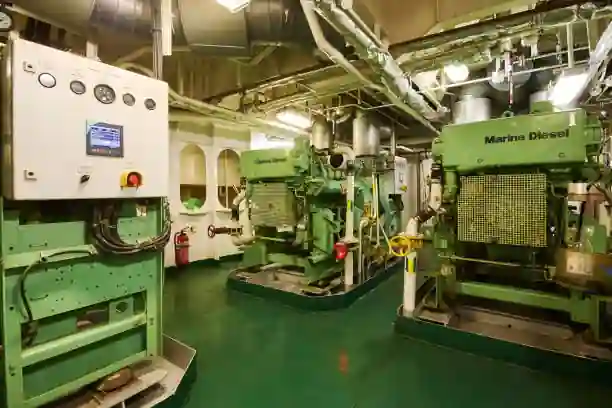
Blog: CPP Control Breakdown, Repair, and Calibratons | Marine and Ship Engineering Experts
Imagine you're on a cruise ship, gliding gracefully across the azure expanse of the ocean. What makes this elegant voyage possible? One of the unsung heroes of maritime technology: Controllable Pitch Propellers (CPPs). These marvels of engineering are instrumental in steering ships through calm and turbulent waters, offering precise control and unmatched efficiency. In this blog, we'll take you on a journey into the depths of CPPs, exploring their parts, operation, and how they work their magic on the high seas.
The Anatomy of a Controllable Pitch Propeller:
A Controllable Pitch Propeller consists of several key components that work together seamlessly to propel a vessel:
-
Hub Assembly: At the heart of a CPP is the hub assembly, which connects the blades to the ship's propulsion system. It allows the blades to change their angle or 'pitch.'
-
Blades: CPP blades are specially designed to pivot on their hubs, which distinguishes them from fixed-pitch propellers. The ability to adjust the blade angle is crucial for varying the thrust and maneuverability of the vessel.
-
Actuators: These hydraulic or electric devices control the pitch of the blades. By adjusting the blade angle, the ship's crew can optimize propulsion efficiency and vessel maneuverability.
-
Control System: The control systemis the brain of the CPP. It receives commands from the bridge and communicates with the actuators to adjust the blade pitch as needed.
Operation of CPPs:
CPPs are incredibly versatile and offer precise control over a vessel's movement. Here's how they operate:
-
Variable Blade Pitch: Unlike fixed-pitch propellers, CPPs allow the blades to change their angle of attack. This feature enables the ship's crew to adjust the thrust and optimize fuel efficiency in various conditions.
-
Forward and Reverse: CPPs can easily switch between forward and reverse thrust, allowing ships to navigate tight spots in ports and harbors with ease. This capability is particularly valuable for docking and maneuvering.
-
Fine-Tuned Control: The ability to adjust the blade pitch allows for fine-tuned control of the ship's speed and direction. This precision is essential for navigating through narrow channels, avoiding obstacles, and maintaining stability in rough seas.
How CPPs Work:
Now, let's dive deeper into the mechanics of CPPs:
-
Changing Blade Pitch: When the ship's crew wants to alter the vessel's speed or direction, they send a signal to the control system. The control system then adjusts the pitch of the blades through the actuators.
-
Optimizing Thrust: By changing the blade pitch, CPPs can vary the amount of thrust generated. This flexibility is especially valuable in situations where the ship needs to conserve fuel or quickly respond to changing conditions.
-
Efficiency and Maneuverability: CPPs excel at maintaining optimal efficiency across a wide range of speeds and load conditions. This efficiency not only saves fuel but also reduces emissions, making them environmentally friendly.
Introducing Ashmit Engineering: Your CPP Experts
When it comes to CPPs, you need a trusted partner who understands their intricacies and can resolve any issues that may arise. That's where Ashmit Engineering comes in. With our expertise in CPP technology, we have the knowledge and experience to tackle any problem, ensuring your vessels stay on course and operate at peak efficiency.
Whether you require real-time phone call support, remote monitoring and control support, or technical assistance for various vessel, ship, and cargo CPP control systems, Ashmit Engineering offers steadfast support, services, breakdown assistance, and maintenance. Our dedicated team is primed to ensure your maritime ventures sail smoothly from start to finish.
In summary, CPPs represent a feat of maritime engineering, and with Ashmit Engineers by your side, you have the assurance of expertise and support for all your CPP needs. So, the next time you embark on a sea adventure, take a moment to appreciate the technology that keeps you sailing smoothly through the waves – the remarkable CPPs, with Ashmit Engineering poised to offer technical support, assistance for various vessel, ship, and cargo CPP control system, along with maintenance services and breakdown assistance.
Tags :
- Controllable pitch propellers
- CPP
- Marine propellers
- Ship propulsion
- Fuel efficiency
- Maneuverability
- CPP experts
- Maritime technology
- Ship engineering
- Marine engineering
- CPP maintenance
- CPP repair
- CPP design
- CPP manufacturing
- CPP installation
- Controllable pitch propeller maintenance services
- Controllable pitch propeller repair services
- Controllable pitch propeller design services
- Controllable pitch propeller manufacturing services
- Controllable pitch propeller installation services

